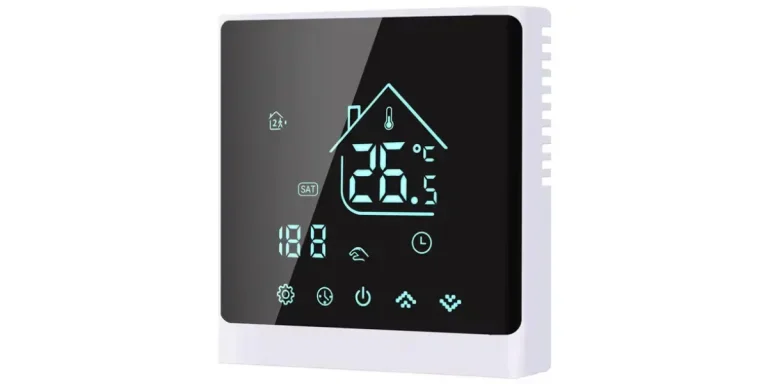Smart thermostat technologies are becoming increasingly important in the world of home climate control. These little devices help users accurately customize and automate temperatures throughout the day, saving energy and maintaining economical climate regulation. Coupled with wireless technology, such control is now as easy as turning a dial on your phone.
This comprehensive guide will cover everything you should consider before choosing a smart thermostat for retail.
Table of Contents
Overview of the smart thermostat market
Types of smart thermostats
A guide to buying the right smart thermostat
Summary
Overview of the smart thermostat market
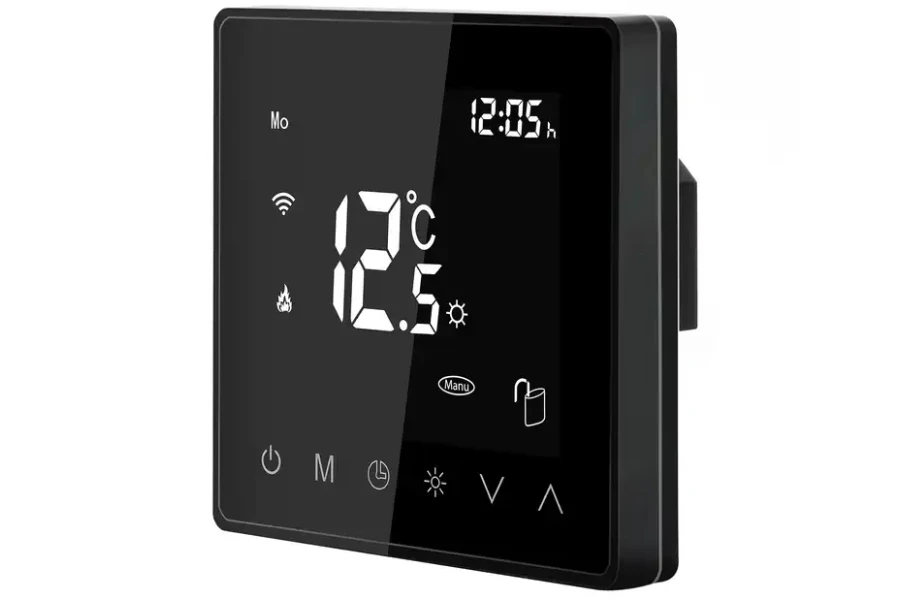
A report published by Mordor Intelligence shows that the smart thermostat market is experiencing substantial growth, and is poised to surge from USD 4.45 billion in 2023 to a projected USD 11.12 billion by 2028, indicating an impressive CAGR of 20.10% during the forecast period (2023-2028). The main force leading to high demand is the increased focus on energy efficiency and sustainability among customers who want to minimize their energy use and, in turn, energy bills.
Regions with high demand for smart thermostats include North America and Europe, where there is a general push toward automation as well as strict energy regulations combined with higher public awareness of environmental sustainability.
Types of smart thermostats
1. Programmable smart thermostats
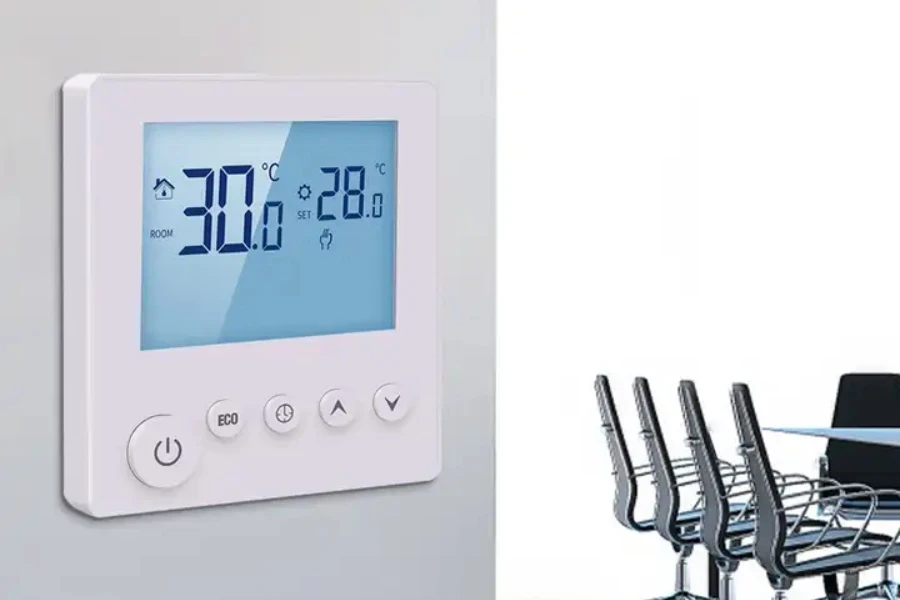
Smart programmable thermostats help to adjust the temperature of a house or individual room according to a specific schedule or daily schedule, economizing power. These thermostats are mostly linked to an app so that users can operate them remotely or via voice-assisted virtual assistants such as Amazon Alexa or Google Assistant.
Features
- Programmable smart thermostats allow users to create personalized heating and cooling schedules based on their daily routines, optimizing energy efficiency
- Users can set specific temperatures for different times of the day, ensuring comfort while reducing energy consumption
- Many programmable thermostats provide insights into energy usage patterns, allowing users to make informed decisions for cost savings
2. Learning smart thermostats
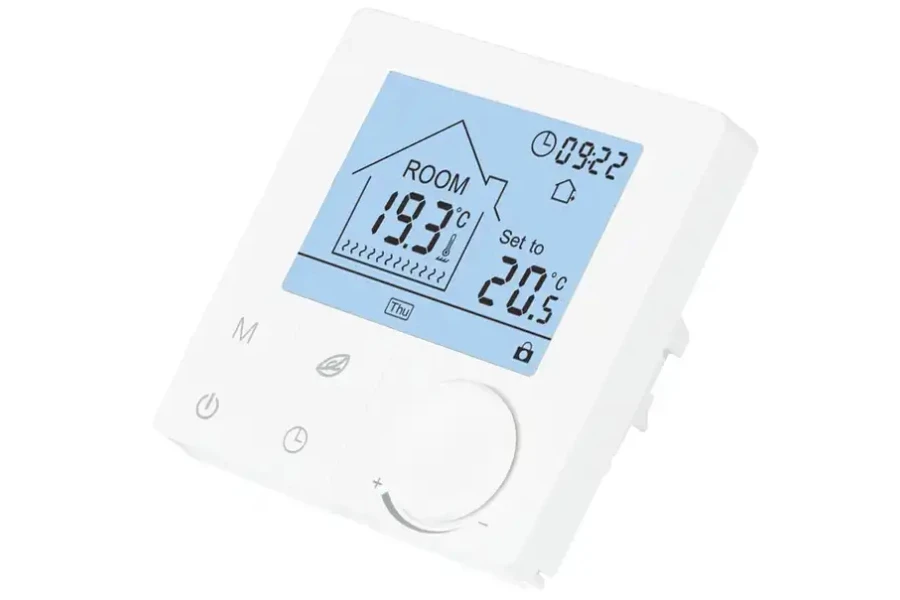
Smart learning thermostats feature upgraded climate controls that utilize algorithms developed to comprehend and adjust to a user’s preferences. Over time, they learn the user’s habits and adjust temperatures accordingly, optimizing energy consumption without manual programming.
Most such thermostats also have an app and voice-control functions that simplify their remote management.
Features
- Learning smart thermostats utilize artificial intelligence to adapt to user’s preferences and behaviors over time, automatically adjusting settings for optimal comfort
- These thermostats often incorporate sensors to detect occupancy and environmental conditions, fine-tuning temperature settings accordingly
- Learning thermostats can be controlled remotely through smartphone apps, providing flexibility and control even when away from home
3. Remote-controlled smart thermostats
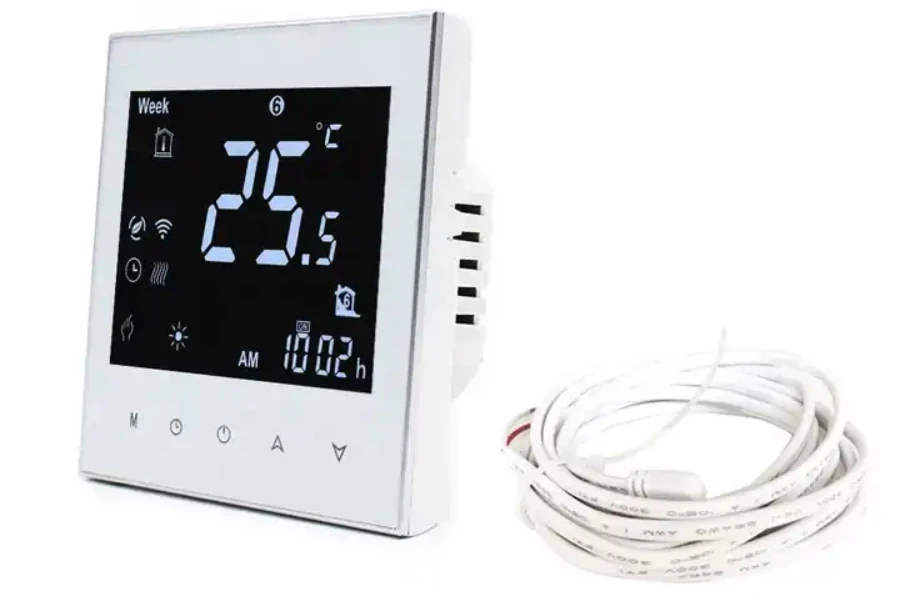
Smart thermostats, operated via mobile apps, allow people to adjust temperatures remotely. They can therefore be integrated with Wi-Fi-enabled technologies in modern homes, allowing users to monitor and control the climate even when away from home.
Features
- Remote-controlled smart thermostats feature Wi-Fi connectivity, enabling users to control temperature settings from anywhere with an internet connection
- Many models integrate with voice-controlled virtual assistants like Alexa or Google Assistant, allowing users to adjust settings using voice commands
- Users can monitor and adjust home temperatures in real-time through dedicated apps, providing convenience and flexibility for on-the-go temperature management
A guide to buying the right smart thermostat
1. Price

- Programmable smart thermostats: Programmable smart thermostats, ranging in price from USD 100-250, offer the convenience of creating personalized heating and cooling schedules and cater to users looking for energy efficiency without the advanced learning capabilities of higher-end models. The mid-range pricing reflects the inclusion of customizable schedules, temperature control features, and energy usage monitoring, providing a balance between affordability and functionality.
- Learning smart thermostats: Learning smart thermostats, priced between USD 150-300, cost a little more due to the inclusion of adaptive technology and artificial intelligence. These thermostats adapt to user preferences over time, adjusting settings automatically for optimal comfort and energy savings. The higher price range also reflects advanced features such as sensor integration for occupancy detection and smartphone compatibility, making them an ideal choice for those seeking a more intuitive and efficient heating and cooling experience.
- Remote-controlled smart thermostats: Remote-controlled smart thermostats, available at between USD 80-200, are designed to provide users convenient temperature control from anywhere with internet access. Their pricing is reflective of their primary features, including Wi-Fi connectivity and compatibility with voice-controlled virtual assistants. While they may lack some advanced learning capabilities, these thermostats offer a cost-effective solution for users who prioritize remote control and real-time monitoring without the higher costs associated with learning capabilities.
2. Compatibility
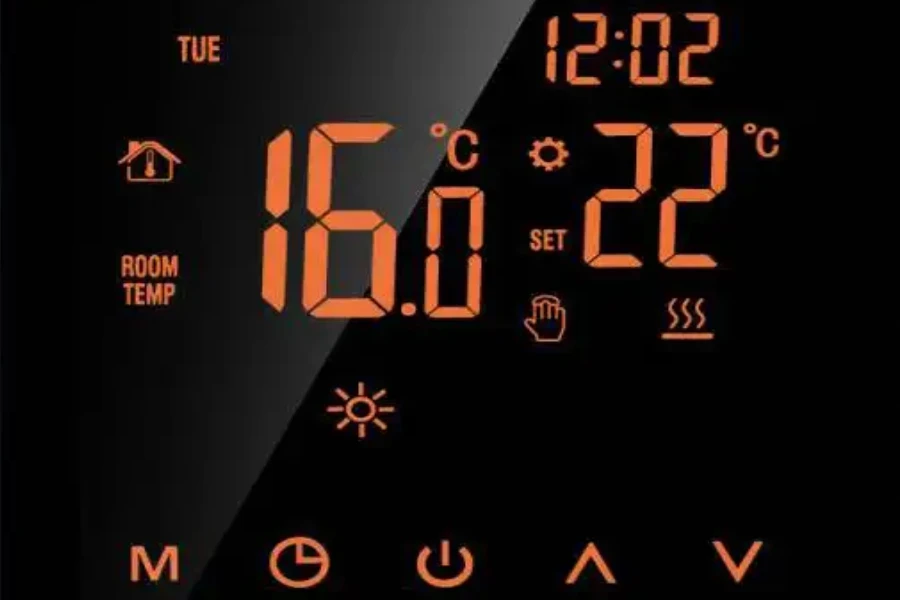
Before buying, it’s best to confirm the smart thermostat’s connectability with HVAC systems and other appliances.
Programmable smart thermostats should be compatible with a variety of heating, ventilation, and air conditioning (HVAC) systems commonly found in homes. Ensuring compatibility with a specific HVAC system guarantees that the thermostat can effectively control the temperature and optimize energy usage based on your schedule.
In addition to compatibility with various HVAC systems, learning thermostats often integrate with sensors and occupancy detectors. This compatibility enables the thermostat to adapt and learn users’ daily routines, automatically adjusting temperature settings for maximum comfort and energy efficiency.
Compatibility for remote-controlled thermostats extends beyond HVAC systems to include connectivity features. These thermostats should be compatible with Wi-Fi networks, enabling remote access through smartphone apps. Additionally, compatibility with voice-controlled virtual assistants like Alexa or Google Assistant enhances user convenience, allowing temperature adjustments via voice commands.
3. Connectivity
In most cases, smart thermostats are connected via Wi-Fi for remote monitoring and controlling of settings through dedicated mobile apps, making their usage flexible and convenient.
Ensure that they are also compatible with SmartHome OS, either Google Home or Apple Homekit, helping to ensure that they can be updated with new functionalities, security improvements, and software.
4. Energy efficiency
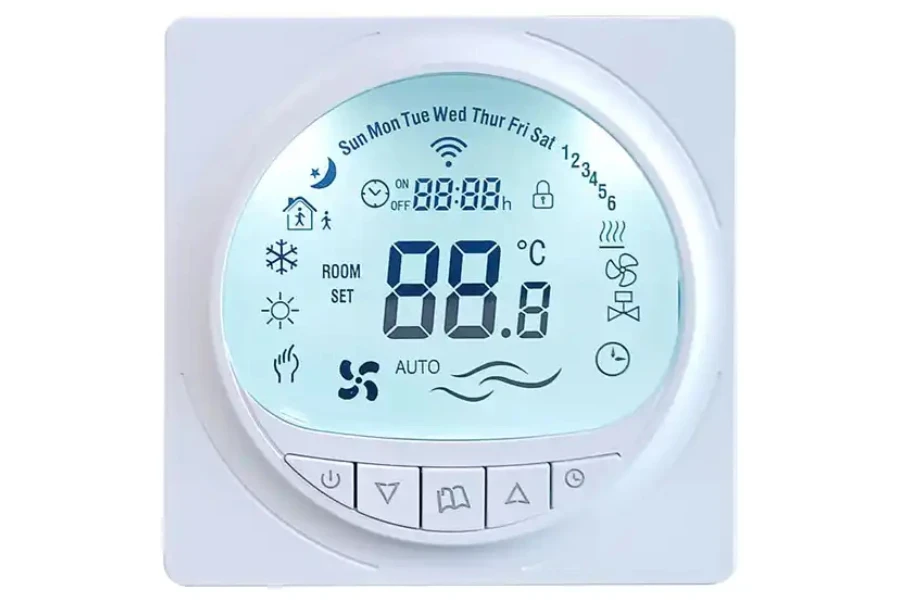
Programmable thermostats are designed to function seamlessly within the standard 24V low voltage systems commonly used in heating and air conditioning setups. By allowing users to set customized schedules, these thermostats efficiently manage temperature control, optimizing energy usage based on individual preferences. Their compatibility with standard low-voltage systems ensures effective operation and enables users to achieve a balance between comfort and energy savings.
Learning smart thermostats operate on the principle of adaptability, automatically adjusting to users’ preferences and habits. This dynamic capability not only enhances comfort but also leads to significant reductions in electricity costs. As these thermostats learn from daily routines and temperature adjustments, they can fine-tune settings over time, making them a valuable investment for those looking to achieve optimal energy efficiency without manual intervention.
Remote-controlled thermostats offer a high level of efficiency, providing users with the convenience of adjusting temperatures from anywhere with internet access. While their remote capabilities enhance flexibility, it’s important to note that user habits and behavior patterns can also influence them. This means that users’ interactions, such as frequent adjustments or unexpected changes, can impact the thermostat’s performance.
5. App and voice control
Smart thermostats have been redefined via app and voice control functionalities for improved user experience. An ideal thermostat will have an easy-to-use mobile phone app that allows for remote monitoring and temperature adjustment.
6. Ease of installation
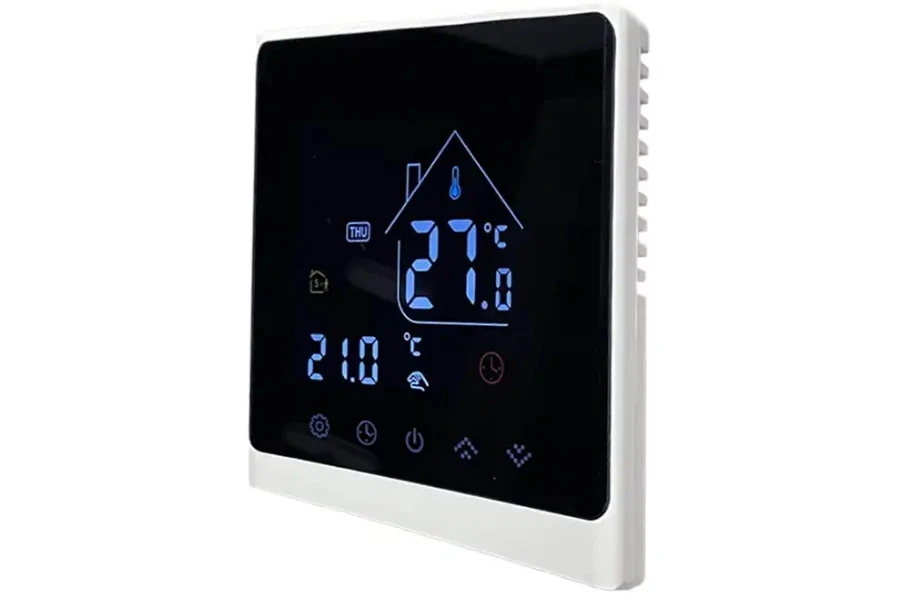
Installing programmable thermostats is typically straightforward, involving connection to the existing wiring of your heating or cooling system. Most models come with user-friendly interfaces and clear instructions, making it a manageable DIY project for those comfortable working with basic electrical connections. Professional installation is also an option for those who prefer assistance or have more complex HVAC systems.
The installation process for learning smart thermostats is similar to that of programmable thermostats, focusing on wiring compatibility with your HVAC system. Added interactivity comes from the initial configuration and connection of the thermostat to Wi-Fi networks for remote access. While DIY installation is possible, some users may opt for professional installation, especially if integrating additional sensors or components.
Installing remote-controlled thermostats involves connecting the device to a heating or cooling system and ensuring compatibility with the home’s Wi-Fi network. These thermostats are designed to be user-friendly, and step-by-step guides are often provided for DIY installation. Professional installation services are available for those who prefer expert assistance or have specific requirements, ensuring seamless integration with your home’s HVAC system and connectivity features.
Summary
When buying smart thermostats, it’s essential to consider price, suitability, efficiency, app connectivity, and voice control. Balancing these elements will help to ensure that you source the right smart thermostat models for your retail business. For a huge range of smart thermostats that are sure to match your needs, visit Alibaba.com.
